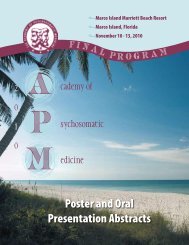Table of Contents - Academy of Psychosomatic Medicine
Table of Contents - Academy of Psychosomatic Medicine
Table of Contents - Academy of Psychosomatic Medicine
You also want an ePaper? Increase the reach of your titles
YUMPU automatically turns print PDFs into web optimized ePapers that Google loves.
medical and behavioral health expenditures and increased<br />
satisfaction.<br />
13. Impact <strong>of</strong> Collaborative Care for<br />
Depression in Public Sector, Primary Care<br />
Clinics<br />
Presenting Author: Isabel Lagomasino, MD, MSHS<br />
Co-Authors: Megan Dwight-Johnson, MD, MPH, Naihua<br />
Duan, PhD, Jennifer Green, MSW, Lily Zhang, MS, Lingqi<br />
Tang, PhD, Jeanne Miranda, PhD<br />
Purpose: To examine the effectiveness <strong>of</strong> a collaborative<br />
care intervention tailored to the preferences and constraints<br />
<strong>of</strong> low-income, ethnic minority patients and their providers in<br />
public sector primary clinics.<br />
Methods: 402 primary care patients from 3 public sector,<br />
Los Angeles clinics were recruited through waiting room<br />
screening or provider referral and randomized to a 4-month<br />
collaborative care intervention vs. wait list control. Adults<br />
were eligible if they spoke English or Spanish and had a depressive<br />
disorder, using the Patient Health Questionnaire-9<br />
(PHQ-9) and PRIME-MD. Bilingual, entry-level social workers<br />
provided psycho education and <strong>of</strong>fered a choice <strong>of</strong> shortterm<br />
cognitive-behavioral therapy, antidepressant medication,<br />
or both. Primary care providers provided prescriptions;<br />
a psychiatrist supervised social workers’ caseloads and<br />
therapy.<br />
Results: Of 1637 patients screened, 627 (38%) had depressive<br />
disorder. After exclusions, 402 enrolled. Subjects’ mean<br />
age was 49.5; they were 84% women, 85% Latino (86%<br />
Spanish-speaking), 48% with < 6 years education, 64%<br />
unemployed, 56% uninsured. The mean PHQ-9 score was<br />
17.3; 37% <strong>of</strong> subjects had thoughts <strong>of</strong> death/suicide; 62%<br />
had likely comorbid anxiety disorder; 77% reported fair/poor<br />
health; the mean number <strong>of</strong> chronic illnesses conditions was<br />
3.4. Among intervention subjects, 83% received some treatment;<br />
most chose therapy (55% received therapy plus medication,<br />
38% only therapy, 7% only medication). At 4-months,<br />
intervention subjects had significantly improved depression<br />
outcomes (mean PHQ-9 score 8.6 v. 13.3, p



